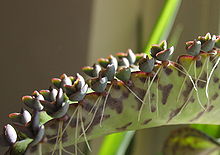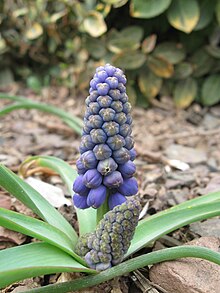This article needs additional citations for verification. (March 2008) |




Vegetative reproduction (also known as vegetative propagation, vegetative multiplication or cloning) is a form of asexual reproduction occurring in plants in which a new plant grows from a fragment or cutting of the parent plant or specialized reproductive structures, which are sometimes called vegetative propagules.[1][2][3]
Many plants naturally reproduce this way, but it can also be induced artificially. Horticulturists have developed asexual propagation techniques that use vegetative propagules to replicate plants. Success rates and difficulty of propagation vary greatly. Monocotyledons typically lack a vascular cambium, making them more challenging to propagate.
- ^ "vegetative reproduction | horticulture". Encyclopedia Britannica. Retrieved 22 September 2017.
- ^ Kershaw, K. A.; Millbank, J. W. (April 1970). "Isidia as Vegetative Propagules in Peltigera Aphthosa VAR. Variolosa (Massal.) Thoms". The Lichenologist. 4 (3): 214–217. doi:10.1017/S0024282970000257. ISSN 1096-1135. S2CID 86138677. Retrieved 4 January 2022.
- ^ RRB, Leakey (31 December 2004). "Physiology of vegetative reproduction". Encyclopedia of Forest Sciences. doi:10.1016/B0-12-145160-7/00108-3. Retrieved 4 January 2022.